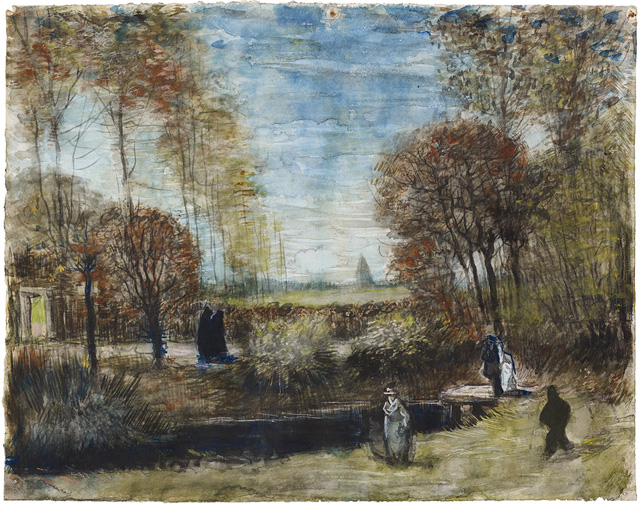At TEFAF 2013 you will find Kunsthandel Ivo Bouwman at booth number 333. You are most welcome to get acquainted with a variety of artworks, and a new addition: The vicarage garden with figures, by Vincent van Gogh.
Vincent van Gogh (1853-1890)
The parsonage garden with figures, late October – early November 1885
Brush in opaque and transparent watercolour, on wove paper, 38 x 49 cm
Watermark: J WHATMAN 1881
The parsonage garden with figures is a drawing of significant importance in Van Gogh’s oeuvre for a number of reasons. It was the preliminary work for a large painting that has since been lost and only remains in poor-quality monochrome reproductions. The drawing therefore provides an insight into how the painting may have looked in colour. The purpose of both works was to produce a fictional, arranged piece featuring figures – exactly the sort of work that Van Gogh had aspired to produce ever since becoming an artist. It is also his first experiment with a subject that he returned to in Paris and Arles – figures and couples strolling through an attractive garden or elegiac park. As one of Van Gogh’s last Nuenen works (and the only drawing), the work also demonstrates the greater clarity in use of colour he developed after visiting the Rijksmuseum in early October 1885.
Van Gogh was enthralled with autumn in late October and early November 1885, which led to the production of several landscapes. In a letter to his brother Theo about one of these works, he wrote: ‘I’ve also made another autumn study of the pond in the garden at home. There’s definitely a painting in that spot. […] The one I’ve made now is something of a stiff composition; two trees (orange and yellow) on the right, two bushes (grey-green) in the middle, two trees (brownish yellow) on the left. In front – the pond, black – foreground of withered grass. Background, a glimpse over the hedge onto a very bright green. A sky to harmonize with this in terms of power, in slate-grey and dark blue’. It’s striking that Van Gogh fails to mention the presence of the figures. This indicates that he is writing about the drawing, as this work originally only depicted an unembellished autumn landscape – the figures and the tower were added at a later stage. The drawing became the preliminary work for the painting, lost in 1944.
Van Gogh was extremely fond of the garden behind the parsonage and it was a setting that inspired him to create multiple, occasionally extremely ambitious works. These works often feature the tower in the fields behind the garden. However, when Van Gogh set his hand to The parsonage garden with figures, the tower was no longer part of the scenery – from May 1885 onwards, the mediaeval construction was dismantled in stages. Van Gogh brings the tower back to life for this work: the drawing is a fictional composition arranged by the artist and the tower is a necessary, atmospheric element.
Van Gogh had already portrayed figures in nature or a park, but the drawing and the lost painting are the first mature productions that address a subject that was to become an important, poetically-charged motif in his work: walkers and lovers in a park. This may be a private garden, but it is clear to see that Van Gogh has transformed it into somewhere with a completely different character to that which it really had.
It was only a year after moving to Paris early in 1886 that Van Gogh returned to the theme. He left for Arles in 1888 and there he found a pretty park opposite the now famous Yellow House where he lived. The park inspired him to create a series of masterful paintings entitled The poet’s garden and the majority of these paintings feature figures and couples. Dating back to Roman times, the Avenue des Alyscamps was another spot in Arles that inspired Van Gogh to produce similar works. All these works bear witness to Van Gogh’s desire to create art abound with a consolatory character.
Compared to the earlier watercolours, with their robust appearance and solid yet subdued colours, The parsonage garden with figures is characterised by a lighter feel and a looser, in places even facile stroke. Mirroring the pallet of paintings from October – November 1885, the use of colour demonstrates more clarity and contrast than in earlier works. This resulted from a visit Van Gogh paid to the recently-opened Rijksmuseum in October 1885. After studying works by the old masters at the museum, Van Gogh decided that he had been concentrating too heavily on darker elements in his colouring and back in Nuenen, he set about making the changes he deemed necessary. The appealing (and well-preserved) colouration in this work is a fitting example of this new use of colour.
The drawing was probably acquired in 1903 by renowned art critic and lecturer H.P. (Hendrik) Bremmer. Following his death in 1956, the work remained with his heirs until circa 1969 before becoming part of the private collection to which it still belongs to this day.
Sjraar van Heugten

